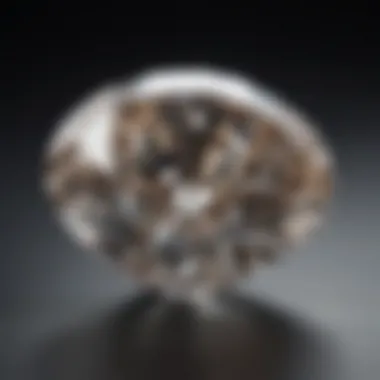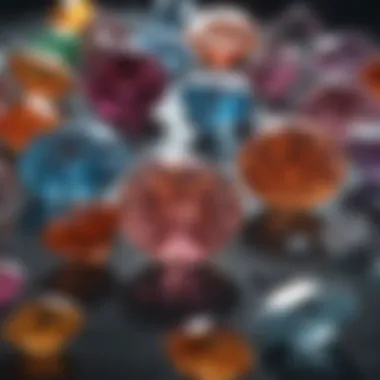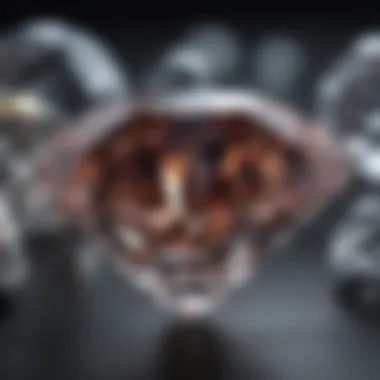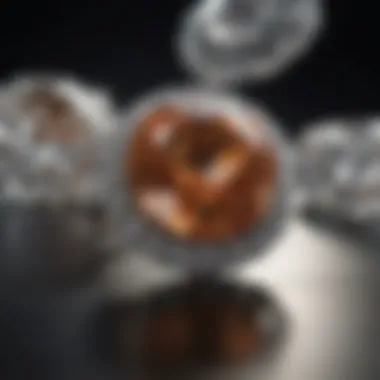Decoding the Cost of High-Value Diamonds


Intro
Gemstone Overview
Definition and Origins
Diamonds are precious gemstones composed of carbon atoms arranged in a crystal lattice structure. This unique configuration gives diamonds their remarkable hardness, making them the hardest known natural material. They form deep within the Earth’s mantle under extreme heat and pressure over millions of years. Although many associate diamonds with engagement rings and luxury, their origins are rooted in natural geological processes that are anything but simple.
Historical Significance
Historically, diamonds have been symbols of wealth and power. As far back as the 4th century BC, diamonds were valued for their beauty and durability. They were favored by royalty and used in both jewelry and weaponry. Through the ages, diamonds have shaped economies and influenced trade routes, especially during the diamond rushes of the 19th century in South Africa and Australia. Notably, these gems have often been tied to significant cultural moments, signifying love, commitment, and prestige.
Gemstone Properties
Hardness and Durability
Diamonds are well-known for their hardness, which is rated a 10 on the Mohs scale of mineral hardness. This characteristic not only enhances their desirability but also contributes to their market value. Individuals value diamonds for their ability to withstand scratches and maintain brilliance over time. However, it is essential to note that while diamonds are durable, they can still chip or break under certain conditions, typically along their cleavage lines.
Color and Clarity
The color and clarity of diamonds play a crucial role in determining their economic value. While most diamonds are colorless, they can be found in various shades, including pink, blue, and yellow. Generally, the more intense the color, the more valuable the diamond. Additionally, clarity refers to the presence of internal or external flaws, known as inclusions and blemishes. High clarity diamonds with minimal flaws are considerably more valuable, as they possess greater visual appeal.
"The very essence of a diamond’s value lies in its color, clarity, cut, and carat weight, often referred to as the 'Four Cs.' Understanding these factors is essential for any investor or collector."
By identifying these key properties, collectors and enthusiasts can better appreciate the diamonds they encounter in the market. A deeper understanding of these features not only adds to the enjoyment of owning such a gemstone but also serves to inform purchasing decisions and investments.
Prelims to Diamond Valuation
Diamond valuation is a critical aspect of understanding the economics surrounding high-value diamonds. It provides a comprehensive framework for evaluating the worth of these exquisite gemstones. Diamonds are not merely ornamental; they signify status, investment potential, and emotional significance. This section introduces the principles that underpin diamond valuation, helping the reader appreciate its complexities.
Defining Diamond Value
When discussing diamond value, several key factors must be considered. Primarily, a diamond’s worth is influenced by its rarity, quality, and market demand. Most often, value references shift daily due to economic fluctuations and consumer preferences.
At the core of defining a diamond's value are several attributes:
- The Four Cs: Carat weight, Cut, Color, and Clarity. These criteria serve as a standard for pricing diamonds and assessing their quality.
- Rarity: Not all diamonds are created equal. Certain types, notably rare colors like pink or blue, can command extraordinarily high prices due to their scarcity.
- Market Trends: Prices can vary due to trends influenced by cultural perceptions, economic conditions, and even celebrity endorsements.
"Every diamond tells a story, but its value is crafted by measurable attributes and market perceptions."
Understanding these components aids buyers and collectors in making informed decisions. It also allows investors to view diamonds not just as jewelry, but as assets with significant monetary implications.
Overview of Market Dynamics
The diamond market operates under unique dynamics that distinguish it from other luxury items. Several facets influence how diamonds are valued and traded on the market:
- Supply and Demand: The fundamental economic principles of supply and demand significantly affect diamond prices. An increase in demand, coupled with limited supply, can lead to soaring values.
- Global Market Trends: Economic factors such as recession or boom periods can alter consumer behavior. For instance, during economic downturns, luxury item sales tend to decline. Conversely, in prosperous times, spending on luxury goods, including diamonds, often rises.
- Influence of Technology: The rise of synthetic diamonds has introduced new dynamics into the market. Their availability and lower cost may exert downward pressure on natural diamond prices, causing shifts in consumer preferences.
- Cultural Influences: Trends in fashion often dictate what types of diamonds are sought after. Celebrity culture plays a pivotal role in establishing desirability, creating specific market demands.


Analyzing these market dynamics provides insight into the complexities of diamond valuation. The intersection of rarity, consumer preferences, and economic conditions creates a landscape that is continuously evolving. In understanding this landscape, investors and enthusiasts can make decisions that reflect both knowledge and savvy in the diamond market.
The Four Cs of Diamonds
The valuation of diamonds is dictated by several crucial factors, one of which is the well-known framework of the Four Cs: Carat weight, Cut quality, Color grading, and Clarity. Each of these elements plays an essential role in determining a diamond's worth, and understanding them provides deeper insights into the economics of high-value diamonds. Thus, a thorough grasp of the Four Cs serves not just jewelers or collectors, but anyone aiming to navigate the diamond market effectively.
Carat Weight Considerations
Carat weight refers to the size of the diamond, and it is often one of the first metrics considered when evaluating value. The term "carat" originates from the carob seeds that were historically used as weight reference. A single carat is equivalent to 200 milligrams.
While larger diamonds generally command higher prices, this is not a linear relationship. For example, a two-carat diamond does not cost just double that of a one-carat diamond. The price escalation can be drastic for larger stones due to their relative rarity.
Attaining a diamond of significant carat weight merges desirability and rarity factors, making them particularly sought after. Buyers often favor well-balanced carat weight and quality over sheer size, emphasizing the importance of the other Cs as well.
Cut Quality and Its Impact
Cut quality is arguably one of the more subjective aspects of diamond valuation. It refers to how well a diamond has been shaped and faceted. A superb cut can enhance a gemstone's brilliance and sparkle, while a poor cut can detract from even a high-carat stone's appeal.
Different facets, angles, and polishing methods influence how light interacts with the diamond. The grading ranges from Excellent to Poor, where a higher grade results in more light return, increasing the stone's overall value.
An ideal cut not only optimizes appearance but also ensures that the diamond's physical attributes are highlighted, reinforcing its market value. Thus, cut quality significantly contributes to a diamond's appeal in the high-value segment.
Color Grading Systems
Diamond color grading measures the absence of color in a diamond. The Gemological Institute of America uses a scale that ranges from D (colorless) to Z (light yellow or brown). Colorless diamonds are rare and, therefore, pricier. They exhibit maximum brilliance as they reflect light without interference.
Interestingly, some colored diamonds, such as blue or pink, are also included in this category but are judged by entirely different standards. Due to their stunning rarity and thought-provoking beauty, their value can be astronomical.
Therefore, understanding these grading systems is critical for buyers, as it enables them to make informed decisions about color considerations in high-value diamonds.
Clarity and Rarity Effects
Clarity refers to the presence of imperfections or inclusions in a diamond. These can be internal (inclusions) or external (blemishes). The grading system ranges from Flawless to Included, with the latter significantly impacting a stone's price.
While all diamonds possess some level of imperfections, those graded as Flawless or Internally Flawless demand much higher prices due to their extreme rarity. The clarity also ties into the diamond's overall appeal; fewer inclusions often mean a more luminous and mesmerizing appearance.
In essence, clarity affects rarity, and since rarity amplifies value, diamonds showcasing higher clarity grades appeal more to buyers willing to invest heavily.
Key Insight: The interrelated dynamics of carat weight, cut quality, color grading, and clarity play a fundamental role in defining the character and economic value of high-value diamonds.
Types of High-Value Diamonds
The exploration of high-value diamonds is critical in understanding their economic significance within the jewelry market. High-value diamonds, often characterized by their unique colors and rarity, influence market trends, pricing strategies, and consumer preferences. Each type embodies distinct properties that contribute to its allure, making them sought after by collectors, investors, and enthusiasts alike. Understanding these specific diamond categories not only enriches appreciation but also highlights the intricate dynamics at play in the luxury gemstone market.
Pink Diamonds
Pink diamonds are among the rarest gemstones globally. Their stunning color ranges from soft pastel tones to vibrant shades. The intensity of pink is a key factor in determining value, with deeper hues commanding higher prices. These diamonds derive their color from unique lattice defects during their formation process, a phenomenon that remains largely unexplained.
Investors are particularly interested in pink diamonds due to their limited availability. The Argyle mine in Australia, once the primary source, has ceased operations, making existing stocks even more precious. The market has observed significant auction results, with pink diamonds achieving record prices, underscoring their investment potential.
Blue Diamonds
Blue diamonds, noted for their captivating blue hue, owe their color to the presence of boron during formation. The Hope Diamond and the Blue Moon Diamond are famous examples, each possessing a unique story that enhances their desirability. The rarity of blue diamonds makes them a prominent choice for investment, as market demand frequently exceeds supply.
The GIA grading system further contributes to their valuation. The intensity and hue of blue can vary, impacting desirability continuously. Recent auction records reflect a growing trend among investors recognizing blue diamonds as a worthwhile investment, leading to appreciation in their market value over time.
Red Diamonds


Red diamonds are exceedingly rare, often regarded as the most valuable diamonds per carat. With only a handful of authentic red diamonds known to exist, their intrinsic scarcity elevates their status among gemstones. The red hue results from specific structural anomalies, making these diamonds particularly fascinating.
Due to their limited supply and high demand from collectors, red diamonds often fetch astronomical prices at auction. A noteworthy example is the Moussaieff Red Diamond, which is admired for both its color and its provenance. Collectors view these diamonds not just as jewelry but as historical artifacts, enhancing their appeal in the luxury market.
Green Diamonds
Green diamonds are unique due to their color, which typically results from natural radiation exposure. This type of diamond can range from faint to vivid green, with more intense shades being particularly valued. Their green color is relatively uncommon, contributing to their allure and market price.
Though they may not reach the heights of value seen with pink or blue diamonds, collectors appreciate the distinctiveness of green diamonds. Interest in these diamonds has grown, as more individuals seek to own examples of varieties that are not widely available in traditional jewelry stores.
Yellow and Orange Diamonds
Yellow and orange diamonds, often classified under the term "fancy colored diamonds," are gaining more recognition in the market. Their rich hues are due to the presence of nitrogen atoms, influencing both their appearance and value. The vivid yellows are more sought after than lighter shades.
The increasing popularity of these diamonds is evidenced in auction outcomes, where vibrant yellow and orange stones command significantly higher prices than their colorless counterparts. The increasing trend reflects an evolving consumer desire for unique and bold choices in fine jewelry.
"Each type of high-value diamond holds its charm and rarity, making them indispensable in the luxury jewelry market."
The value assessment of yellow and orange diamonds is influenced by factors such as color depth, clarity, and overall aesthetic appeal. Thus, they are often seen as investment options suitable for novice and seasoned collectors alike.
Natural vs. Synthetic Diamonds
The distinction between natural and synthetic diamonds is crucial for understanding the broader economics of high-value diamonds. This topic showcases different elements that contribute to value perception, market trends, and consumer choices. Natural diamonds are formed through geological processes over millions of years and are often viewed as more prestigious due to their rarity and historical significance. In contrast, synthetic diamonds are laboratory-created and can be produced in a shorter time frame, often resulting in a lower price point in comparison.
Understanding Natural Diamonds
Natural diamonds originate deep within the Earth, where high pressure and temperature conditions facilitate their formation. They take millions of years to develop, contributing to their scarcity and allure. The rarity of natural diamonds inherently drives up their market value, making them sought after by collectors and investors alike. The extraction of these gems from the earth is labor-intensive, which further adds to the costs associated.
Natural diamonds exhibit a wide range of characteristics including color, clarity, and carat weight, all of which significantly influence their price. Aspects like diamond grading and certification contribute to buyers’ confidence in their purchase. With increasing awareness about the environment, many consumers are also considering the sustainability aspect of diamond mining. This awareness often leads to higher demand for responsibly sourced natural diamonds that adhere to ethical standards.
Synthetic Diamond Market Trends
The market for synthetic diamonds has grown considerably over the past few years. As technology advances, the production methods for synthetic diamonds have improved, allowing for higher quality stones that can closely resemble natural diamonds.
- Price Differential: Synthetic diamonds are typically sold at a lower price point. This shifts the market dynamics as they provide a more affordable option for consumers who desire the aesthetics of diamonds without the associated costs.
- Consumer Perception: While synthetic diamonds appeal due to their pricing, there remains a stigma among some consumers regarding their authenticity compared to natural diamonds.
- Sustainability Marketing: Many brands market synthetic diamonds as a sustainable choice. These diamonds emit a smaller carbon footprint during production compared to natural mining processes. Thus, consumers inclined toward environmental responsibility may prefer synthetics over natural options.
- Regulatory Aspects: As the market for synthetic diamonds continues to expand, regulations and grading systems are evolving. Ensuring transparency in sourcing and production methods may become pivotal as consumers become more discerning.
Despite the growth of synthetic diamonds, natural diamonds continue to hold a unique position in the luxury market. Their rarity, historical legacy, and cultural significance inform their lasting appeal.
"Understanding both categories helps investors and collectors make informed decisions based on pricing trends and personal values."
By recognizing both natural and synthetic diamonds, enthusiasts can better appreciate the complexities involved in diamond valuation in today’s evolving market.
Market Trends in Expensive Diamonds
Understanding market trends in expensive diamonds is crucial for buyers, sellers, and collectors alike. These trends reflect shifts in consumer preferences, economic conditions, and global events that can influence pricing. A clear grasp of these trends can inform investment choices and value assessments for high-value diamonds.
Auction Results and Historical Records


Auction results provide a wealth of data about the diamond market. They serve as benchmarks for pricing and can reflect the demand and desirability for specific types of diamonds. High-profile auctions, such as those held by Sotheby’s and Christie’s, showcase rare pieces that often set new records. In 2015, the Blue Moon Diamond was sold for a staggering $48.4 million, making it one of the most expensive diamonds ever sold. This record not only indicates the jewel's rarity but also the auction’s role in raising public interest among collectors.
Historical records also reveal how diamond prices have evolved over time. For instance, data shows that the prices of specific rare colored diamonds have increased significantly over the last decade. Factors influencing these price changes include economic stability, celebrity endorsements, and cultural shifts towards sustainable luxury goods. The growing popularity of ethical sourcing also plays a role in how diamonds are valued today.
The Role of Influencers and Celebrities
Influencers and celebrities have an undeniable impact on the perception of luxury items, including diamonds. When a celebrity dons a rare diamond on the red carpet, it can trigger instant demand for similar pieces. For example, the increasing visibility of high-value diamonds worn by celebrities like Beyoncé and Kim Kardashian has sparked a surge in consumer interest.
Social media platforms amplify this trend, as their reach allows celebrities to promote their favorite jewelers and styles to millions. This has led to a rise in both celebrity-commissioned pieces and bespoke designs created for some of the wealthiest individuals.
Moreover, influencer marketing strategies have transformed the way diamonds are marketed. Influencers often share personal stories or showcase unique designs, creating a narrative that resonates with followers. Consequently, the emotional connection that consumers feel towards these luxury items can drive up sales and prices in the market.
Understanding these dynamics is essential for anyone invested in the diamond market. Recognizing the patterns influenced by auction results and celebrity culture allows for informed decisions regarding diamond investment and collection.
The demand for high-value diamonds often correlates with the visibility and status conferred by celebrity culture, illustrating the potent synergy between luxury and influence.
Cultural Significance of Expensive Diamonds
The cultural significance of diamonds extends well beyond their aesthetic appeal and market values. Understanding this aspect is essential for grasping the full economics of high-value diamonds. Diamonds play pivotal roles in various cultures and societies, often interwoven with deep rituals, beliefs, and social structures. They serve as symbols of wealth, power, and status. In different cultural contexts, the meaning attached to diamonds can alter perceptions regarding their value and desirability.
Diamonds in Historical Context
Throughout history, diamonds have been viewed as precious symbols. The earliest known diamond was found in India, and it dates back to the 4th century BC. In ancient cultures, they were believed to possess mystical properties, offering protection and strength to their owners. In the medieval period, diamonds became associated with royalty. The largest diamonds, such as the Koh-i-Noor and the Cullinan, hold a place in royal collections, representing vast wealth and political power. Their desirability was not only rooted in their rarity but also in the status they conferred upon kings and queens.
In modern history, particularly after World War II, diamonds solidified their place in popular culture through marketing campaigns. The slogan "A diamond is forever" significantly increased their association with eternal love and commitment, especially in engagements. This emotional context has dramatically influenced diamond sales and investment as people aspire to own these symbols of exclusivity and devotion.
Symbolism and Status
Diamonds are not merely accessories; they represent social standing. Wearing a high-value diamond signifies one's economic status and can elevate an individual's place in society. They are often gifted during significant life events, such as engagements, weddings, and anniversaries, further cementing their role in personal and social relationships. The choice of diamond type, particularly those that are rare or exhibit unique colors, reflects individual identity and values.
Beyond mere ownership, cultural narratives surrounding expensive diamonds shape consumer behavior. The presence of diamonds in movies, art, and literature reinforces their allure and can invoke strong emotional responses, driving demand. Moreover, political figures and celebrities often adorn themselves with high-value diamonds, setting trends that can influence public perception and desirability.
"Diamonds, as cultural artifacts, embody more than just value; they encapsulate stories of human aspiration, desire, and societal structure."
Thus, the examination of high-value diamonds cannot overlook their cultural dimensions. These gems have become vessels of meaning, representing aspirations, historical context, and deep-rooted social symbols. For gemstone enthusiasts, collectors, and jewelry designers, knowing the cultural significance of diamonds enhances appreciation and guides informed investment decisions.
End: Understanding Diamond Investments
In the realm of high-value diamonds, investments extend beyond mere aesthetic appreciation. Engaging with this topic clarifies the intricate dynamics that shape the market for these precious stones. Diamonds are not just symbols of wealth but also carry historical and emotional significance. Investing in diamonds can be considered akin to investing in art; both require a keen understanding of rarity, quality, and market demand.
Future of High-Value Diamonds
Looking ahead, the market for high-value diamonds presents a mixed landscape of challenges and opportunities. One notable trend is the increasing viability of synthetic diamonds. As technology advances, synthetic diamonds have gained acceptance in the market, sometimes at a fraction of the cost of natural diamonds. This has raised questions about long-term sustainability for natural diamonds as investments. However, the allure of authenticity and rarity continues to play a powerful role in the preferences of many collectors.
Additionally, as consumer preferences evolve, there is potential for certain unique types of diamonds, such as those with specific hues or exceptional clarity, to appreciate in value. The interplay of market forces, consumer sentiment, and innovations in diamond creation suggests that investors should remain vigilant and adaptable.
Final Thoughts on Investment Potential
The investment potential of high-value diamonds lies in their unique characteristics and the knowledge behind them. It is essential for investors to consider the variables that influence diamond prices, like rarity, quality, and overall market trends. Some key considerations include:
- Understanding Market Trends: Awareness of past auction results and current demand can guide investment decisions.
- Critical Evaluation: Investors must carefully assess the quality of the diamond, looking beyond its price tag to the underlying attributes that ensure long-term value.
- Cultural Significance: Diamonds often carry a symbolic weight that can influence desirability and, consequently, investment value.
Investing in diamonds requires both passion and knowledge. For those who navigate this complex terrain wisely, diamonds can indeed become valuable assets.
In summary, understanding diamond investments requires an appreciation for the unique nature of these stones, alongside informed decision-making. As market dynamics change, a nuanced perspective can illuminate potential opportunities and pave the way for successful investments.



